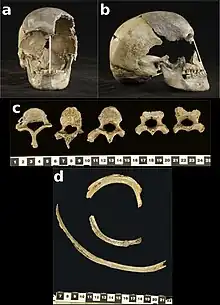Zlatý kůň woman
The Zlatý kůň woman is the fossil of an ancient woman, an Early European modern human, dated to circa 43,000 BP. She was discovered in the Koněprusy Caves in the Czech Republic in 1950.


The Zlatý kůň woman is associated with the Initial Upper Paleolithic, the earliest culture of modern humans in Europe, which expanded into Eurasia more than 40,000 years ago, following their dispersal out of Africa.[1][2][3] On the basis of genetic dating, the Zlatý kůň individual is believed to be the oldest anatomically modern human ever to be genetically sequenced. Her genome represents a deeply splitting lineage basal to the subsequent split between East Eurasians and West Eurasians.[4]
These early Eurasian populations probably mated with Neanderthals in the period between 50,000 and 60,000 years ago, probably during the initial phase of their expansion in the Middle East, and they carried ~2–9% Neanderthal ancestry in their genomes.[5] It is also considered that the early modern humans coexisted with Neanderthals in Europe for a period of about 3,000–5,000 years.[1] The Zlatý kůň woman had a small amount of Neanderthal admixture, going back 70 or 80 generations.[5]
These people do not appear to have been the ancestors of later Europeans, as the very few ancient DNA samples recovered from this period are not related to later samples.[6] The Zlatý kůň woman also has contributed genetically neither to later Europeans nor to Asians.[1]
Among the earliest modern humans that have been directly dated to this period are:[7]
- an individual from 46,000 to 44,000 years ago in the Bacho Kiro cave, located in present-day Bulgaria;
- a 45,000-year-old Ust'-Ishim man (no continuity with later Eurasians);
- a 40,000-year-old Tianyuan man, who is more closely related to modern Asians and Native Americans;
- Oase 1 (no shared ancestry with later Eurasians);
- Fumane 2, circa 40,000 BP.
References
- Prüfer, Kay; Posth, Cosimo (June 2021). "A genome sequence from a modern human skull over 45,000 years old from Zlatý kůň in Czechia". Nature Ecology & Evolution. 5 (6): 820–825. doi:10.1038/s41559-021-01443-x. ISSN 2397-334X. PMC 8175239. PMID 33828249.
- Hublin, Jean-Jacques; Sirakov, Nikolay (11 May 2020). "Initial Upper Palaeolithic Homo sapiens from Bacho Kiro Cave, Bulgaria" (PDF). Nature. 581 (7808): 299–302. Bibcode:2020Natur.581..299H. doi:10.1038/s41586-020-2259-z. PMID 32433609. S2CID 218592678.
- Bower, Bruce (11 May 2020). "The earliest known humans in Europe may have been found in a Bulgarian cave". Science News.
- Vallini, Leonardo; Marciani, Giulia; Aneli, Serena; Bortolini, Eugenio; Benazzi, Stefano; Pievani, Telmo; Pagani, Luca (2022). "Genetics and material culture support repeated expansions into Paleolithic Eurasia from a population hub out of Africa". Genome Biology and Evolution. 14 (4). doi:10.1093/gbe/evac045. PMC 9021735. PMID 35445261.
- Churchill, Steven E.; Keys, Kamryn; Ross, Ann H. (August 2022). "Midfacial Morphology and Neandertal–Modern Human Interbreeding". Biology. 11 (8): 1163. doi:10.3390/biology11081163. ISSN 2079-7737. PMC 9404802. PMID 36009790.
A similarly recent hybridization event (six or seven generations earlier) has been inferred from aDNA of early modern humans at Bacho Kiro, Bulgaria, around 45.9–42.6 Ka [39], while a somewhat more distant event (70–80 generations earlier) has been recognized in the genome of a >45 Ka-old cranium from Zlatý kůň in Czechia
- Callaway, Ewen (1 March 2023). "Ancient genomes show how humans escaped Europe's deep freeze". Nature News. 615 (7951): 197–198. Bibcode:2023Natur.615..197C. doi:10.1038/d41586-023-00611-2. PMID 36859677. S2CID 257282687.
- Prüfer, Kay; Posth, Cosimo (June 2021). "A genome sequence from a modern human skull over 45,000 years old from Zlatý kůň in Czechia". Nature Ecology & Evolution. 5 (6): 820–825. doi:10.1038/s41559-021-01443-x. ISSN 2397-334X. PMC 8175239. PMID 33828249.
A complete genome has been produced from the ~45,000-year-old remains of Ust'-Ishim, a Siberian individual who showed no genetic continuity to later Eurasians. This contrasts with the ~40,000-year-old East Asian individual from Tianyuan, whose genome is more closely related to many present-day Asians and Native Americans than to Europeans. From Europe, only the partial genome of an individual called Oase 1 and dated to ~40 ka has been recovered, and this showed no evidence of shared ancestry with later Europeans
